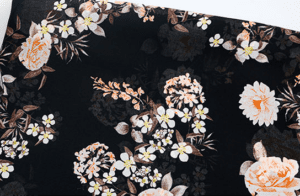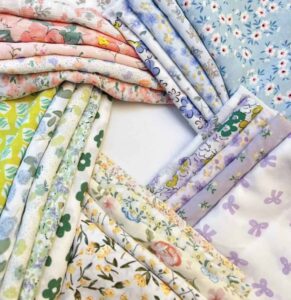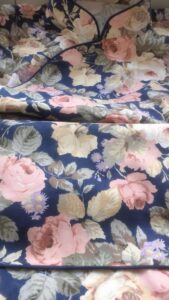The digital transfer printing technology and equipment is now available everywhere, and the market for nylon fabric printing mainly uses screen printing, cold transfer printing, digital direct spray printing and several other methods. Flat or circular screen printing is difficult for complex and delicate colour patterns, and there is a lot of effluent in the printing process. Cold transfer printing, which involves wetting the fabric and transferring it at room temperature, is sensitive to the degree of wetness of the fabric during the transfer process and once the degree of wetness changes during the transfer process, the colour difference is often intolerable. Digital direct-jet printing is the direction in which industry colleagues are working. This is done by ink-jet printing acidic inks on sized fabrics, followed by steam evaporation and washing and drying.
Acid inkjet heat transfer printing on nylon fabric
Acid inkjet heat transfer on nylon fabrics is a great way to get the job done without the need for an opposite
The new process of pre-stocking the fabric with heat transfer is not affected by the humidity of the environment and the fabric has no added feel after the transfer. This is a new process with a much reduced level of contamination and satisfactory printing results.
Acid ink
Acid ink is a type of dye ink that is suitable for digital printing on protein and nylon fibres, and can be used on silk, wool and nylon fabrics to achieve beautiful colours and reduced stains.
Acid inkjet thermal transfer process on nylon fabrics
1 ) A coating with ink acceptance, transfer and colour fixation on a substrate film.
2 ) The coated surface is inkjet printed with acidic ink.
3 ) The printed coating layer can be laminated to the nylon fabric under heated and pressurised conditions.
4 ) The PET film is then peeled off, vapour evaporated, washed and dried to produce a nylon printed fabric.
Acid inkjet thermal transfer conditions on nylon fabrics
1 ) Printing: Acid ink is sprayed onto the transfer film, dried and heat transferred (the film is flat and does not wrinkle during the printing process and can be printed unattended).
2 ) Transfer printing: the printed transfer film is applied to the nylon surface and adhered to the nylon under heated and pressurised conditions, generally at a heating temperature of 120-140 °C and a pressure of 3 to 7 mPa between the rolls (see Figure 1).
3 ) Peel-off: the substrate of the transfer film is peeled off from the nylon fabric, where the transfer coating carries the acid ink pattern fully adhered to the fibres of the nylon fabric.
4 ) Steaming: place the patterned nylon fabric in a steamer at 102-105°C for about 30 minutes.
5 ) Washing: After steaming, the fabric is washed in cold water with a very thin transfer coating and then in hot water with the printed floating colours.
6 ) Drying: the nylon print is dried after washing and the transfer printing is completed.
Fig. 1 Illustration of the transfer
Acid inkjet heat transfer equipment for nylon fabrics
The high pressure during the transfer process allows the transfer coating to penetrate into the nylon fabric, resulting in good colour penetration, and the pressure controls the depth of the print (see Fig. 2).
Print quality results of acid inkjet heat transfer on nylon fabrics
1 ) Washing fastness: 3~4, according to GB/T 3921 I
2008 Colour fastness to soaping standard.
2 ) Dry rubbing fastness: class 4, according to GB/T 3920- 2008 rubbing fastness standard;
3 ) Fastness to wet rubbing: Class 4, according to GB/T 3920-2008 Colour fastness to rubbing.
4 ) print clarity better than other current nylon fabric printing processes.
5 ) The process is stable and the overall pass rate for printing on nylon fabrics can reach over 95 %.
Acid ink in heat transfer Nylon fabric application summary
1) Advantages of acid inkjet thermal transfer on nylon fabrics: transfer film inkjet printing acid ink images are clear and delicate, and the colours of the thermal transfer are bright and beautiful; nylon fabrics before transfer
Fig. 2 High pressure heat transfer machine
Stretch nylon fabrics can also be transferred directly without pre-treatment; acid inkjet heat transfers on nylon fabrics are also compatible with fine heat transfers on silk fabrics (see Fig. 3).
Fig. 3 Finished acid inkjet thermal transfer on nylon fabric
2 ) Acid inks on nylon fabrics have the disadvantage that the print does not penetrate as well as cold transfer printing.
3 ) Acid inkjet thermal transfer printing on nylon fabrics is the transfer of the acid inkjet printing coating of the transfer film to the nylon fabric, which is subjected to steam in both directions in the steamer to promote the dyeing reaction between the acid dye molecules and the fabric fibres, resulting in beautiful colours and delicate patterns on the nylon fabric. Because it is a thermal transfer, the quality of the print is stable without interference from ambient humidity, making it suitable for both small and large individual batches and will be the first choice for fast-responding SMEs with clean production.
Acidic slurry transfer Application
Silk is a jewel of Chinese culture, the queen of fibres. It has been handed down through history and is only available in dreamy colours, warm as jade The silk has a soft and delicate feel, but it cannot meet the needs of the growing material and cultural development of the modern consumer. It is the soft and delicate textures of silk that are used to express the dynamic creativity of Chinese culture in a variety of techniques and artistic forms, and the precision of modern printing to bring out the finest and most delicate patterns.
The acid inkjet thermal transfer process can also be applied to silk fabrics, where the thermal transfer process is similar to that used on nylon fabrics.
Single-sided acid inkjet thermal transfer on silk fabrics
The transfer film is then peeled off and the transfer coating carries the acid ink off to the silk fabric. The silk is then dried and finished to complete the print.
Acid heat transfer on both sides of silk fabrics
It is well known that double-sided printing on silk fabrics is very difficult, as there is a colour difference between the front and the back, with the front side being brilliant and the back side being poor, and it is extremely difficult to match the pattern to the colour. This problem can be solved by applying acid inkjet thermal transfer printing.
Two symmetrical patterns are ink-jet printed on the transfer film, the silk fabric is placed in the middle of the two films and the transfer film is peeled off the front and back of the silk fabric.
The silk fabric used at the G20 Summit in Hangzhou in 2016 was heat transfer printed using acidic ink developed by Suzhou Tsinghua Institute of Technology, and the application was well received.
The use of silk culture deep historical precipitation, the use of all modern technology means to make printing products set technology and art as one, with a modern assembly line to produce the people can afford to buy, use the silk products, so that the fabric of the graceful and noble, the clothing of the clear and elegant, fine printing gorgeous, to show the noble atmosphere of silk supplies.
Fig. 4 Finished acid inkjet heat transfer on silk fabric
























